|
The process of ionization is often referred
to as the "thunderstorm effect". It is well known
that prior to a thunderstorm, animals and even many humans
feel nervous, jittery and irritable; however, after the
storm there seems to be a feeling of calm. Both animals
and humans experience this phenomena. Most people can't
explain this renewed sense of well-being. However, there
is a logical explanation.
The emotional ups & downs before and after a thunderstorm are caused
by the amount of negative ions in the air around us. Prior to a thunderstorm
there is a very high concentration of positive ions in the air. Positive
ions are often pollutants such as dust, bacteria, pollen, chemicals,
and fumes. The storm releases electrical discharges consisting of high
concentrations of negative ions. Negative ions destroy many of these
air pollutants and, therefore, give us a sense of well-being.
When certain kinds of winds begin to blow throughout the
world, hospital admissions, suicides, and crime rates skyrocket.
One country-Switzerland- even accepts the blowing of the "Foehn" during
the commission of a crime as mitigating evidence in court.
These "notorious" desert and sea winds are also
linked to minor illnesses and malaise epidemics. Victims'
claims range from sleeplessness, irritability, tension,
migraines, nausea, palpitations and hot flashes with sweating
o shills to tremor, vertigo, swelling, breathing difficulty,
and frequent intestinal movement. In addition, elderly
persons are affected with depression, apathy, and fatigue.
What causes these "witches' winds," as they
are often called, to differ from others? What do they posses
or lack that make them a dread to the lands or oceans they
blow across? Positive ions.
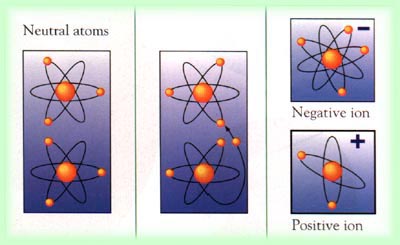
According to the experts, positive ions rob us of our
good senses and dispositions, while their counterpart,
negative ions, enhance them, stimulating everything from
plant growth to the human sex drive..

Approved by the U.S. FDA (Food & Drug Admin.) as an
approved allergy treatment.
In March of 1999, Good Housekeeping Magazine had its engineers test an ionizer by
using a smoke test, and found that it cleared out the smoke in a tank.
A recent study by the U.S. Dept. of Agriculture found
that ionizing a room led to 52% less dust
in the air, and 95% less bacteria in the air (since many
of the pollutants found in the air reside on floating dust
particles).

|
What
causes poor indoor air quality?
Indoor air pollution can be easy to manage
once you understand where it comes from. Looking
at the image above gives you some idea of the more
common sources for poor indoor air quality. In many
cases, it comes from chemicals that are part of the
things that you bring into your home; the polyurethane
common in mattresses, formaldehyde and organic chemicals
like dioxin, polychlorinated biphenyl (PCB) and polybrominated
biphenyl (PBB) used in lots of furniture and other
interior elements are all harmful to us humans. Drapes,
carpets and other absorbent fabrics can help trap
these nasties, along with dust, mites and other allergens,
and our modern, mostly airtight homes keep them inside.
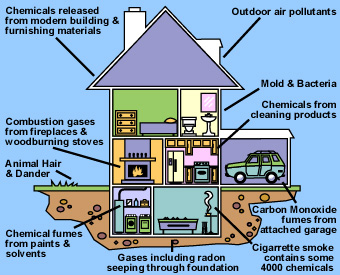
Common Household Chemical Exposures
Symptoms (list is not all inclusive): Brain fog,
irritability, altered mood, fatigue, headaches, tremors,
vertigo, numbness, loss of balance, memory loss,
learning difficulties, depression, asthma, cough,
dry throat, stomach pain, loss of appetite, diarrhea,
constipation, skin rashes, muscle weakness or spasms,
impaired sleep, hormone imbalance, breast tenderness,
PMS like symptoms, menstrual cycle deviations, sweating,
flushing, unusual paleness, loss of libido, and low
sperm count. |
Negative
ions improve asthma and other respiratory conditions.
There is nothing subjective about a bawling baby"
Brazilian hospitals now commonly use negative ion generators to treat
breathing problems, after a test involving 36 children with asthmatic
allergies. In each case, the problem was consistent or crippling. During
the treatment, only one of them suffered an asthma attack. Afterward,
no attacks were suffered by any of the children that sustained regular
negative ion therapy (Soyka, 1991).
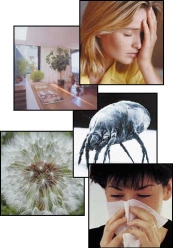
In 1966, a hospital in Jerusalem conducted a study involving
38 babies, between the ages of two and twelve months, with
about the same degree of respiratory problems. The babies
were separated into two groups of nineteen. One group was
treated with nothing but a negative ion electronic air
cleaner, while the second group was administered the standard
treatment, which included drugs and antibiotics with side
effects. The babies in the group treated with the negative
ion air purifier were cured of asthma and bronchitis much
more quickly than those in the control group. The babies
in the negative ion group were also found to be less prone
to rebound attacks. Less scientifically, doctors found
that the babies treated by negative ion-enriched air didn’t
cry as often or as loudly. But as Fred Soyka, the author
of The Ion Effect puts it, "there is nothing subjective
about a bawling baby" (Soyka, 1991).
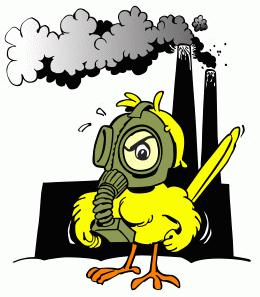
Did you know...
5 billions of pounds of chemicals that the institutional
cleaning industry uses each year
275 active ingredients in antimicrobials that the EPA classifies
as pesticides
Indoor pollution levels can be up to 100 times as much as outdoors
In the average American home, there are 63 synthetic chemical products
found in those homes= 10 gallons of harmful chemicals
READING
THIS ALONE MAKES ME WANT TO INSTALL
IONISER IN ALL THE KIDS ROOMS
23 gallons, or 87 liters, that a conventional janitor
uses every year = 25% hazardous 90% time spent indoors
Only 30% of the 17,000 petrochemicals available for home use have
been tested for human health and environmental exposure

|
"Monotonous Regularity"
In 1975, an East German doctor, who had
by then treated more than 11,000 individuals with various
respiratory conditions with a negative ion electronic
air cleaner, said that his patients reported with "monotonous
regularity" that the therapy had worked (Soyka, 1991).
In the early 1960s, Dr. A. P. Wehner used negative ion generators to
treat over 1,000 patients in the U. S. suffering from various respiratory
ills, such as bronchial asthma, pulmunary emphysema, laryngitis, bronchitis,
dry hacking cough, upper respiratory tract infection, and allergies.
He reported that the symptoms completely disappeared in 30.3% of the
cases, improved significantly in 42.3% of the cases, showed some improvement
in 20% of the cases, and showed no signs of improvement in 7.4% of the
cases (Wehner, 1962).
Indian
Point: New York City's Nuclear Reactor
The Nuclear Regulatory Commission (NRC) has publicly
stated that thousands of deaths from non-accidental,
routine releases of radiation are acceptable in the
nuclear fuel cycle nationwide. (Federal Register
46 FR 39580)
When the plants first opened, both Indian Point
reactors released radioactive gases to the air for
one to two hours twice a day (Atomic Energy Commission,
Sep 3, 1974). That was changed to every two weeks,
but is now back to several times every week.
More |

It’s all in the numbers
In Britain, two Oxford University statisticians
conducted a study among victims of asthma, bronchitis,
and hay fever. The sample was randomly selected from a
list of people who had purchased a negative ion air purifier.
Through interviews, they found that 18 of 24 asthmatics,
13 of 17 bronchitis sufferers, 11 of 12 hay fever victims,
and 6 of 10 suffering from nasal catarrh, reported that
the product had noticeably improved their condition. A
few even reported that it cured their condition (Soyka,
1991).
When a negative is better
than a positive
Postive ions, which occur in high levels
in many indoor environments, inhibit the body’s ability
to prevent pollutants and contaminates from entering the
vulnerable areas of the respiratory tract. However, an
overdose of negative ions has proven to provide counteraction
to this effect (Kreuger, 1974; Soyka, 1991; Tchijewski,
1960).
Reduce and/or destroy bacteria,
viruses and other microbes
U.S. Dept. of Agriculture
A recent study by the U.S. Dept. of Agriculture
found that ionizing a room led to 52% less dust in the
air, and 95% less bacteria in the air (since many of the
pollutants found in the air reside on floating dust particles).
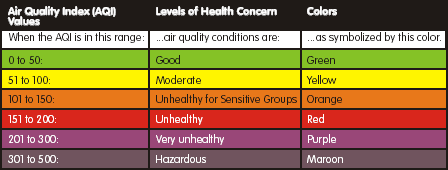
The Air Quality Index is a tool used by EPA and other
agencies to provide the public with timely
and easy-to-understand information on local air
quality and whether air pollution levels pose a
health concern. The AQI tells the public how clean
the air is and whether or not they should be concerned
for their health. The AQI is focused on health
effects that can happen within a few hours or days
after breathing polluted air.
Air
Quality in Texas |
Agriculture Research Service (of USDA)
The Agriculture Research Service of the U.S.
Dept. of Agriculture tested the effectiveness of ionizers
for removing dust in a poultry hatchery. The dust level
is very high in such an environment. In this study, the
use of an ionizer resulted in dust removal efficiencies
that averaged between 81.1 and 92.2%. The airborne transmission
of salmonella (to the eggs) was also significantly reduced
as a result.
Journal of Hygiene
Scientists showed that ionization reduced
bacterial levels in burns and plastic surgery units by
over 96% after a two week period, which results in much
better and more rapid healing of patients.
Journal of Applied Microbiology
The use of negative ions was even found
by scientists to reduce the presence of airborne viruses
by about 40%. A study featured in the 1987 issue also showed
the negative ions are free from any adverse side effects.
Negative
ions are needed in order to take in oxygen.
"Please, we’re
dying here!"
Russian scientist, Dr. A. L. Tchijewsky,
tried raising mice, rats, guinea pigs, and rabbits in totally
de-ionized air. Almost all of them died within two weeks
due to an inability to utilize oxygen properly (Tchijewski,
1960).
Tchijewsky’s colleague, Dr. D. A. Lapitsky, tried
raising small animals in air completely devoid of oxygen.
He added only negative ions to the air as they were about
to die from asphyxiation. At which point, their respiration
frequency drastically increased, as they began to sit up
and run around the chamber (Tchijewski, 1960).

Don’t travel to space
without `em
Former NASA scientist James B. Beal,
who came across the negative ion problem while studying
the type of environment needed in space capsules, wrote: "The
human race was developed in ionized air. Nature used the
ions in developing our biological processes." In other
words, people have been designed to function properly in
an environment that contains certain level of ionization
(Soyka, 1991).
The more the better
Fred Soyka, author of "The Ion Effect" reports
that based on the 5,000 plus scientific documents that
have been published regarding negative ion studies, all
support the conclusion that an overload of negative ions
seems to be beneficial (Soyka, 1991).
Negative ions counteract
the effects of smoking.
High levels of negative ions neutralize the effect that
tobacco smoke has on the cilia. Cilia are the microscopic
hairs located in the trachea that move rapidly back and
forth to prevent pollutants and toxins from traveling into
the vulnerable areas of the respiratory tract. The faster
the cilia move, the more effective they are. However, tobacco
smoke slows down the ciliary beat, diminishing the body’s
ability to keep cancer-causing pollutants from entering
the depths of the respiratory tract. Tests have shown though,
that adding high levels of negative ions to the air accelerates
the ciliary beat to normal levels (Soyka, 1991).
Negative ions help prevent
respiratory-related illnesses.
"I hope I’m in
group one."
In a study conducted in a Swiss textile
mill, negative ionizers were placed in two, 60’ by
60’ rooms, each containing 22 employees. In one room,
the negative ion electronic air cleaner was turned on during
the course of the study. In the other room, the negative
ion air purifier was permanently turned off, although the
employees in this room were led to believe they were working
in a room enriched by negative ions. During this six-month
study, a total of 22 sick days were lost by employees working
in the room in which the negative ionizer was operating.
In the room where the machine was not operating, a total
of 64 days were lost to sickness. During a month-long flu
epidemic, the first group lost a total of 3 days to sickness,
while the second group lost a total of 40 days to sickness
(Stark, 1971).
In a test involving a Swiss bank office, one group of
309 worked in a negative ion-treated environment. A second
group of 362 worked in an untreated environment. Over the
next several months, for every day lost to respiratory
illness (cold, flu, laryngitis, etc.) in group one, 16
days were lost to respiratory illness in group two (Soyka,
1991).
"We liked them so much
. . ."
In a Surrey University study at the Norwich
Union Insurance Group headquarters, eight negative ion
generators were placed in the computer and data preparation
section. Before the test, the research team spent a month
compiling incident rates for complaints of sickness and
headaches. During the test in which the negative ion air
purification systems were in operation, incidents of sickness
and headaches were reduced by 78%. After testing was completed,
the Norwich Union opted to keep the negative ion electronic
air cleaners (Soyka, 1991).

Negative ions help prevent
migraine headaches.
Migraine headaches originate when an overload of serotonin
causes the diameter of blood vessels leading to the brain
to dilate, and get wider in the brain. Consequently, blood
flow increases, and pain receptors in the vessels are stretched,
which leads to the excrutiating pain associated with a
migraine headache (Borne, 1998; others). In numerous tests
and studies though, negative ion treatment has proven to
prevent the overproduction of serotonin, and therefore
the subsequent migraine headaches (Kreuger, 1957; Soyka,
1991; Sulman, 1974).
Out with the Bad Air… -
sick buildings
At this moment, a threat that you can't see and
have trouble identifying could literally be sucking
the life out of your business--and your employees.
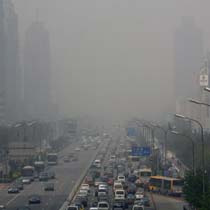
We spend 90 percent of our time indoors, much of
that at work; according to the Occupational Safety
and Health Administration (OSHA) and the EPA, many
of us are breathing air that's making us sick or
uncomfortable. Both agencies rank indoor air quality
(IAQ) among the most serious environmental problems
in the United States. More |
Negative ions are a natural
anti-depressant.
. . . and without the side effects!
In a study conducted by Columbia University, 25 people with SAD (Seasonal
Affective Depression) sat in front of a negative ion air purifier for
a half hour every morning for a month. Half the subjects were given
a low level of negative ions, and the other half a high level. The
higher level of negative ion treatment proved to be as effective against
SAD as antidepressants, such as Prozac and Zolof, and without the side
effects of these drugs (Finley, 1996).
Negative ions for a positive
attitude
Positive ions, which are found in abundance
in most indoor environements, cause an overproduction of
serotonin. Serotonin is a neurotransmitter that helps the
body deal with mental, emotional, and physiological stress.
An overproduction initially causes hyperactivity, which
rapidly leads to anxiety, and in some cases depression.
Negative ion treatment has proven to be successful in reducing
the overproduction of serotonin, and therefore successful
in alleviating depression in some cases (Kreuger, 1957).
Negative Ions Help Combat
Fatigue.
In 1957, a study published in the Journal of General Physiology
concluded that negative ions reduce the overproduction
of serotonin, a neurohormone that leads to exhaustion,
among other things, when overproduced (Kreuger, 1957).

Negative
Ions Enhance Mental Performance and Concentration.
The Alpha wave rythms say
it all
In 1969, Dr. Sulman, head of the department
of Applied Pharmacology at Hebrew University in Jerusalem
at the time, brought in groups of people to spend some
time in a room low in negative ions, and also in a room
that contained an "overdose" of negative ions.
While in each room, subjects were given word, figure, and
symbol tests. They scored "significantly higher" on
these tests when they were in the negative ion-enriched
room. Plus, while in the negative ion room, they showed
(via the electroencephalogram) a slower, stronger pulse
rate of Alpha waves from the brain. Alpha wave rythms are
a measure of the brain’s acitivity and health. A
slow, strong Alpha wave pulse rate indicates healthiness,
calmness, and heightened alertness. When the subjects were
in the negative ion-deficient room, they showed signs of
irratibility and fatigue in addition to lower test performance
(Sulman, 1974).
The more difficult the better
In the study conducted by Surrey University
at the Norwich Union Insurance Group headquarters, the
employees in the computer and data preparation section
that were exposed to high levels of negative ions showed
a 28% increase in overall task performance. The more difficult
the task, the more dramatic the improvement tended to be
(Soyka, 1991).
Driving mad
In 1972 in Geneva, statistics showed
that whenever there was a drastic change in the weather,
and a consequent drop in the negative ion concentration
in the air, traffic accident rates rose by more than 50%
(Soyka, 1991).
Negative
ions enhance physical performance.
The Ion Olympics
After World War II, the Russians extensively
studied the relationship between negative ions and physical
performance. A team of doctors, psychologists, and physicists
observed and measured the performance of Olympic athletes
in various conditions of negative ions levels. In each
test of physical performance, the group that trained in
facilities, and stayed in quarters high in negative ion
concentration showed tremendous improvements in performance
in comparison to the control group (Minkh, 1961).
Negative Ions help
us to sleep better.
In 1969, French researcher found that the overproduction
of the neurohormone serotonin caused sleeplessness and
nightmares. In using a negative ion electronic air cleaner
to treat a group of people experiencing sleeping problems
as a result of serotonin overproduction, he found that
most of them were able to sleep better (Soyka, 1991).
Negative ions aid in the
treatment of burn patients.
In 1959, Dr. Kornbleuh treated a group of 138 burn victims
at Northeastern General Hospital with negatived ionized
air. Within this group, 57.3% suffered significantly less
pain and discomfort, while healing more quickly and thoroughly.
Only 22.5% of the control group (the group of burn victims
treated through conventional methods rather than negative
ionization) experienced similar improvements in the same
time frame. Statistically, the odds are 1,000 to 1 that
these results were coincidental. This study, along with
other follow up tests, were evidence enough for the hospital,
which subsequently equipped its postoperative wards with
negative ion generators. The effectiveness of negative
ion treatment in these tests are likely a result of the
extraordinary ability of negative ions to remove pollutants
from the air, resulting in reduced infection and irritation
of burn wounds (Kornbleuh, 1959).
This article from Consumer Reports seems to refute some
of the claims stated in your "New Negative Ion Generator" article
concerning health benefits.
Elton M Bryant Jr
By adding negative ions to indoor air, you are restoring
the natural balance of ions and eliminating many of these
pollutants. Consequently, people living and working in
these environments should experience fewer headaches, less
illness and have more energy left over at the end of the
day. An improved sense of well-being can only contribute
to their overall happiness and productivity.

Breathing Clean Air Can Lengthen Life Expectancy
The researchers, using data from 51 metropolitan areas,
were able to determine that when fine-particle air pollution
dropped by just 10 micrograms per cubic meter, the average
life expectancy of a person went up by up to 8 weeks.Their
study can be found in the New England Journal Of Medicine
.jpg)
|
|
Our
Latest heavy
Duty 5 in1 Delux Home Tower
Air purifier/Ionizer
Air Purifier UV Sterilize Negative Ion generator
Remove Smog Dust PM2.5 , Air bornes bacteria and
virus
Applicable Area: 20-40 m2
 Key Features Key Features
 Efficient eliminate airborne contaminates such as dust, pollen, mold,
smoke, pet dander, and bacteria, germs, allergens. Efficient eliminate airborne contaminates such as dust, pollen, mold,
smoke, pet dander, and bacteria, germs, allergens.
 UV lamp destroys micro-organisms such as germs, viruses and bacteria,
and helps create a healthier environment. UV lamp destroys micro-organisms such as germs, viruses and bacteria,
and helps create a healthier environment.
 Quiet operation. Quiet operation.
 Runs 7-24 cleaning. Runs 7-24 cleaning.
 low energy use low energy use
 Particulate CADR 200m3/H Particulate CADR 200m3/H
 HEPA Filter Negative Ions Anion Ionization Air Purifier UV Light HEPA Filter Negative Ions Anion Ionization Air Purifier UV Light
 Filter: Pre-filter + HEPA + Activated Carbon Filter: Pre-filter + HEPA + Activated Carbon
 Sensor: Dust Sensor/PM2.5 Sensor Sensor: Dust Sensor/PM2.5 Sensor
 Negative Ion: 8 million Negative Ion: 8 million
 UV Sterilize UV Sterilize
 Remote Remote
 Voltage 120-240V Voltage 120-240V
More information
Special
Free
replacement filter and UV tube (Value $59.95)with
every
unit sold till (Dec 2024)
Only
10 left
|
|
|
|
|
Are you Getting Enough Oxygen ?
Oxygen is one of the most important keys to good
health, but not everyone is aware of it. Currently
scientists are examining the role oxygen starvation
plays in the development of disease.
CE Approved
Accurate oxygen saturation and pulse rate data
in seconds
Easy to use; automatically turns on/off with finger insertion/removal
Compact size fits easily into a pocket
|
| |
|

| |
Ionizer Air Purifier
Single
Room
Special
Features
• Super purification
• 15 million super-high concentration of negative ions
to clean indoor air
• With a built-in import material carbon
cobalt alloy stainless steel needle
• Ultra-low power
|
|

